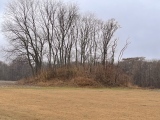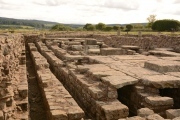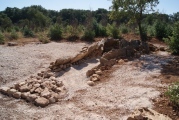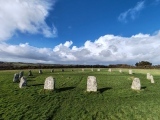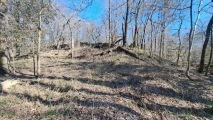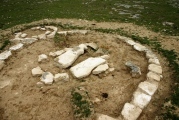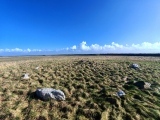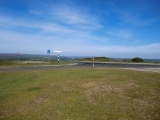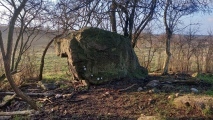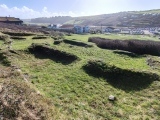Andy Burnham's Blog, page 32
March 4, 2025
Grace Mounds
In addition to photos, Stonetracker has uploaded some videos of this and nearby mound sites, linked in the comments on our pages. Earliest accounts of this site describe five mounds. Now only two remain: Mound A and B. The site was used for habitation during the Coles Creek period as early as 850 CE. The mounds themselves were built during mid to late Mississippian (1200-1600 CE). Unclear whether they served as burial mounds, temple/ceremonial mounds, or a more likely a combination. All the mounds are on private property but Mound A, the largest one, is next to the pull-off area.
Published on March 04, 2025 08:04
March 3, 2025
Hadrian's Wall (Coria)
Located just to the west of modern-day Corbridge, this site was occupied longer than any other along the line of Hadrian's Wall. Established in the AD80s, occupation continued until AD160. After this date, when the fort was extended, granaries rebuilt, and a town extending to around 12 hectares grew up. The importance of this site springs from its location at the junction of Stangegate and Dere Street, along with construction of a bridge crossing the River Tyne (the river ceases to become tidal at Corbridge).
Published on March 03, 2025 11:07
Rego da Murta dolmen 2
The Rego da Murta Megalithic Complex in Leiria, Portugal consists of 14 monuments, including dolmens, menhirs, atypical structures without funerary functions, and a rock art panel featuring cup-marks and connecting grooves. Among the archaeological sites, two dolmens have been fully excavated: Dolmen I and Dolmen II of Rego da Murta. We have photos and references to the excavations of Dolmen II and Dolmen I on our pages.
Published on March 03, 2025 10:46
March 2, 2025
Merry Maidens (Circle)
Proposed mobile phone mast in sight of The Merry Maidens, The Pipers etc. Local residents are objecting and you can give your views online, see the latest comment on our page. Restored in the 1860s, this 23.8m (78-foot) perfect stone circle is Cornwall's pride and joy. Each of the nineteen stones is about 1.2m (4 feet) high, and evenly spaced at about 3.7m (12-foot) intervals. There is a well-known tradition that the stones represent maidens who were turned into stone for dancing on the Sabbath.
Published on March 02, 2025 09:42
Windsor Mounds
The Windsor Mounds are located just over half a mile north of a better-known Mississippi tourist destination, the ruins of Windsor Castle, an antebellum mansion that burned to the ground during a party in 1890 (also well worth a visit!). The adjacent mound site includes four Indian mounds overlooking a tributary of Bayou Pierre.
Published on March 02, 2025 09:40
March 1, 2025
Yeni Turcan Mound
Burial Mound at Yeni Turcan, Azerbaijan, with Two Statues.
This most unusual burial mound was excavated as part of a rescue dig in 2007 due to an expanding limestone quarry. The statues appear to be male and female with their top or heads broken. The reason for this damage or burial is unknown but it is plausible that the images were ceremonially killed at a time when an old, perhaps polytheistic religion was giving way to a new one.
This most unusual burial mound was excavated as part of a rescue dig in 2007 due to an expanding limestone quarry. The statues appear to be male and female with their top or heads broken. The reason for this damage or burial is unknown but it is plausible that the images were ceremonially killed at a time when an old, perhaps polytheistic religion was giving way to a new one.
Published on March 01, 2025 10:05
February 28, 2025
Trerathick Cove Kerb Cairn
Trerathick Cove Kerb Cairn has large kerbstones, The lowest layer of the stony mound survives. It's 23 x 20m (75ft by 65ft) with an interior off centre hump of 1m (3ft 6in) high. Some of the white quartz kerbstones measure 1.5 by 0.6m (5ft by 2ft). The position of the kerbstones suggests that another smaller round barrow (with it's own small kerb) is attached on the eastern side of the main kerb cairn.
Published on February 28, 2025 04:10
Sil Howe
More about Sil Howe and the geology of the Cleveland Dyke at Teesside Psychogeography 'The Smell of Water', the link is in the comments. An early bronze age round barrow now destroyed, it once stood on the Whinstone Ridge, North Yorkshire. A large rim fragment of a collared urn was removed from the barrow prior to 1817 and ended up in Whitby museum.
Published on February 28, 2025 04:10
February 26, 2025
Schälchenstein Stegelitz 3
A newly discovered cup marked stone on a pasture southeast of the village of Stegelitz in Brandenburg. The stone with the newly discovered cup marks lies on the edge of a destroyed burial mound that appears to have contained a dolmen and this was probably the capstone. The burial mound had already been registered, but the cups on the stone were previously unknown. It has at least 5 cup marks on the east-facing side.
Published on February 26, 2025 09:26
February 25, 2025
Mawgan Porth Settlement
The remains of an ancient settlement on the slopes to the north above the stream which runs into Mawgan Porth. Now (or certainly back in the 1970s/80s) surrounded by a pitch and putt minigolf course, some of the remaining hut circles feature as obstacles on the course.
Published on February 25, 2025 10:51

